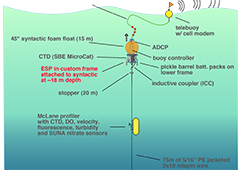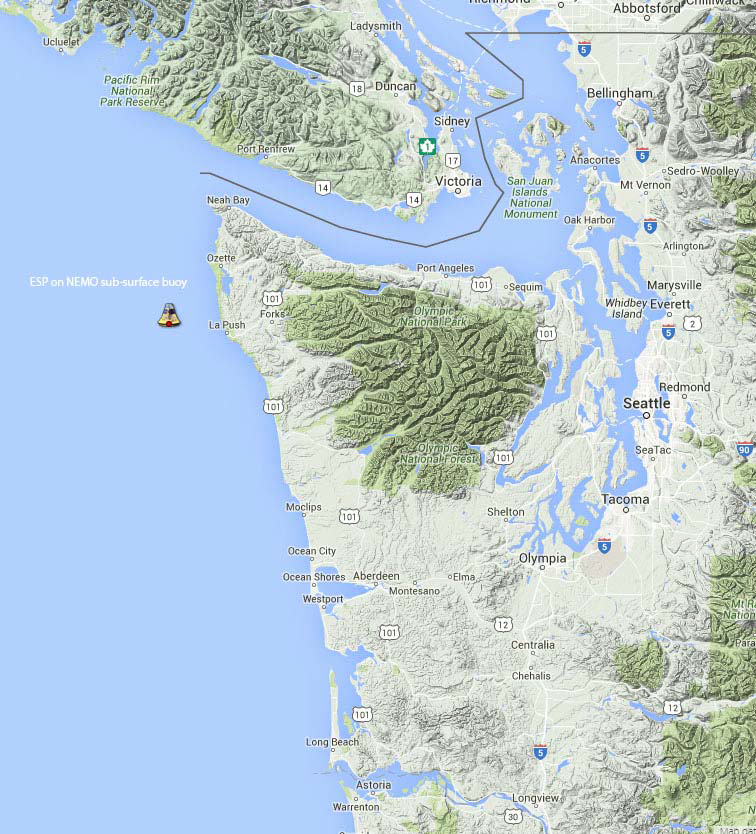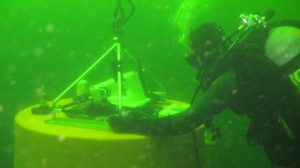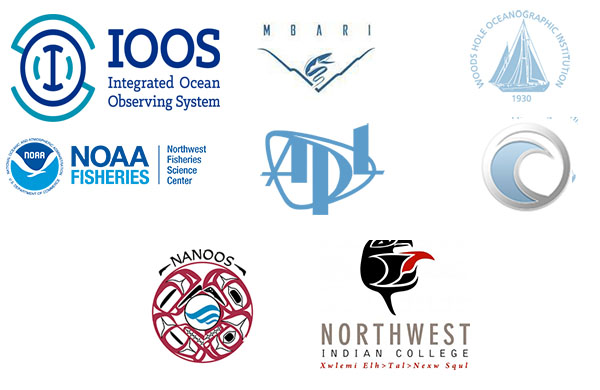Shellfish contamination from harmful algal blooms (HABs) is both costly and a significant health risk to coastal communities. Blooms of Pseudo-nitzschia can produce the neurotoxin domoic acid (DA). DA can bio-accumulate in marine shellfish and finfish and be transferred to humans and wildlife through consumption of contaminated seafood (Scholin et al., 2000). DA poisoning causes gastrointestinal effects (vomiting, nausea, and diarrhea) and neurological effects (headache, dizziness, confusion, disorientation, short-term memory deficits, and motor weakness), with more severe cases resulting in seizures, cardiac arrhythmias, coma, and possibly death (Perl et al., 1990; Teitelbaum, 1990). Short-term memory loss is permanent; thus, the illness is termed amnesic shellfish poisoning (ASP).
In addition to being a significant health risk, toxic blooms of Pseudo-nitzschia have caused coast-wide, yearlong closures of the razor clam fishery in WA resulting in an estimated $24.4 million in annual lost expenditures (Dyson and Huppert, 2010). Coastal Tribal communities may be disproportionately impacted by toxic HABs because shellfish are an integrated part of the culture as well as being significant dietary items and income sources.
To assess the risk of toxic Pseudo-nitzschia blooms impacting coastal beaches, managers use a number of different data types to develop HAB forecasts, including modeled surface currents, observed coastal wind time series, Columbia River flow, sat.ellite imagery, and (critically) the type, number, and toxicity of Pseudo-nitzschia cells. Information on Pseudo-nitzschia is obtained from beach monitoring; however, the primary source of toxic cells of Pseudo-nitzschia is offshore.

Diagram of a buoy mooring and buoy in the Gulf of Maine ESP schematic. (Click graphic for expanded view (pdf).) Credit: Larry Workman, Quinault Indian Nation.
In 2014, IOOS awarded a grant to the University of Washington Applied Physics Lab (APL-UW) to place an autonomous, underwater, robotic marine biosensor (i.e., the Environmental Sample Processor [ESP]), developed by the Monterey Bay Aquarium Research Institute (MBARI) and operated by the NOAA Northwest Fisheries Science Center, on a proven APL-UW/Northwest Association of Networks Ocean Observing System (NANOOS) subsurface mooring located 15 miles offshore of La Push, Washington within the Olympic Coast National Marine Sanctuary. This effort will improve the ability to provide advanced warning of toxic Pseudo-nitzschia blooms and reduce both the negative health and economic impacts of HABs on the Washington Coast. In near real-time the ESP will detect Pseudo-nitzschia cells and their associated toxin DA that escapes from the nearby Juan de Fuca eddy, which has previously been identified as source of HABs.
These observations will be distributed to coastal shellfish managers and other users to enable informed and timely management decisions. Additionally, the project will engage Tribal communities on seafood safety and advanced environmental monitoring through outreach, education, and training, which will include summer internships and Summer Science and Art Camps through the Northwest Indian College. Development and inshore testing of this system will begin in the fall of 2014, with the first offshore operational deployment scheduled for the shellfish harvesting seasons in the spring-fall of 2016.
The environmental intelligence generated by this project will advance the ability to improve forecasts of natural hazards (i.e., toxic HABs), and minimize public health risks associated with consumption of shellfish contaminated with HAB toxins. Specifically, this project will help Washington State managers and Tribes mitigate the risks associated with HABs by providing sustained, reliable, and timely observations and forecasts of HABs and their toxins. By providing a regional context for interpreting local monitoring results, managers of coastal clam resources can inform their communications with stakeholders and community members, so that they may plan a safe, productive season.
This project is comprised of a multi-sector team of partners that combines expertise from academia (UW’s Applied Physics Laboratory and School of Oceanography, Northwest Indian College (NWIC), and Woods Hole Oceanographic Institute (WHOI) ), IOOS (NANOOS), government (NOAA’s Northwest Fisheries Science Center and Center for Coastal Environmental Health and Biomolecular Research), and the private sector (MBARI).
Project Details
Funded activities are listed below by implementation year. Status updates will be added to this page as the project progresses.
Year 1 - $600,000 (September 2014 – August 2015):
- Design and conduct physical modeling of the NANOOS NEMO-subsurface mooring integrated with the ESP. Immediately to the S/SE of the Juan de Fuca eddy is the real-time Northwest Enhanced Moored Observatory (NEMO) located in 100-m of water off the Washington coast. NEMO, established in 2010, is owned and operated by the UW and NANOOS and consists of a heavily-instrumented surface mooring, Cha’ba (named by the Quileute Tribe and meaning “whale tail”), a companion subsurface profiling mooring 400 m away (NEMO-subsurface), and a Seaglider that collects spatial measurements along a 190-km track. . NEMO is positioned in an ideal location to detect toxic cells of Pseudo-nitzschia escaping from the Juan de Fuca eddy bloom initiation site. Update: Design and physical modeling were largely completed in the first 6 months of the project. Fabrication of the complete mooring system and integration the mooring frame,ESP pressure case, power system, pump system and telemetry system with the ESP electronics were completed.
- Prepare and Test ESP for deployment. APL/UW engineers will work closely with engineers at WHOI and MBARI to adopt and integrate key components of their existing ESP mooring systems into NEMO-subsurface. Update: Preparations to retrofit the NWFSC ESP (called ESPfriday) to conduct dual HAB species and toxin analysis are completed along with electronics/processing upgrades with support from MBARI personnel . Reagents and arrays were also ordered and received in support of the August 2015 field tests. Project partners carried out work to streamline ESP data handling and display, with this system was tested following the August 2015 test deployment in Puget Sound. Work still remains to accurately auto-process the images for domoic acid detection and concentration. A test deployment of ESP on the NEMO-SS mooring was carried out from August 6 - 19, 2015 in the Main Basin of Puget Sound.
- An American Indian Student Summer Internship will be offered during each project year, targeting junior or senior students enrolled in the Native Environmental Science program at NWIC. Student internships will be hosted at NWIC, NWFSC, UW, Quinault Indian Nation, or Quileute Natural Resources. The student will receive NWIC credit and NWIC staff support. The host institution will co-design the student research project inspired by the ESP that will expose the student to current best thinking and advanced technology for environmental monitoring and prediction. Update: As part of an internship sponsored through this program via the NWIC, in July and August 2015, NWIC student intern Jessica Williams worked with the NWFSC and APL to prepare the ESP mooring for the test deployment and participated in the test deployment cruise. At the end of this internship she presented a poster to the students and faculty at NWIC summarizing the ESP technology.
Year 2 - $738,000 (September 2015 – August 2016):
- Operationally deploy the ESP. ESPfriday will be deployed operationally on the modified NEMO-subsurface mooring off the WA coast, with engineers from UW/APL, MBARI and WHOI. The deployments will take place annually to coincide with historical periods of razor clam toxification from DA and peak times for razor clam harvesting. The first deployment will occur in May 2016 during scheduled mooring maintenance on the NEMO system. The ESP will be programmed to sample the water for both HAB species and DA once every 2-5 days, with more frequent sampling leading up to scheduled razor clam digs to inform management decisions.This configuration will allow for a total of 22 samples to be analyzed onboard the ESP using genetic detection of Pseudo-nitzschia by a sandwich hybridization assay (SHA) and antigenic detection of DA by competitive enzyme-linked immunosorbent assay (cELISA) over ~2-3 months. This sampling schedule is within the planned battery capacity. A special recovery cruise will be conducted in June and the ESP will be brought back to the laboratory to be serviced and restocked with reagents. Update: ESPfriday was successfully deployed off of La Push, WA on the NEMO buoy between May and July 2016. Originally scheduled for deployment in August 2016, the Washington State Department of Fish and Wildlife and other end-users requested a spring launch following the devastating 2015 West Coast HAB that occurred earlier in the season. A multi-agency team from NOAA (NCCOS & Northwest Fisheries Science Center), IOOS, and the University of Washington came together to make that launch happen, and the new ESP was successfully deployed May 23 on a mooring within the Olympic Coast National Marine Sanctuary near the Juan de Fuca eddy, a known HAB hotspot. ESPeddie relayed data on harmful algal bloom (HAB) species and domoic acid toxin concentration through the NANOOS' Visualization System. The resulting data are the first near-real time ESP observations publically available to end-users in near-real time on the west coast.
- Purchase 2nd ESP, and integrate with APL ESP System
Applied Physics Lab diver Nick Michele-Hart verifying the operation of the pump system on the ESP mooring at 17 m depth. Credit: UW Senior Field Engineer Eric Boget.
- Update: ESPeddie was received from McLane labs in February 2016, with integrated and fixes to APL's ESP system completed in March 2016.
- The 2nd ESP will be redeployed on NEMO-SS in late summer 2016 and again recovered in October during scheduled mooring maintenance. Update: The Fall 2016 ESPeddie deployment was successful. ESPeddie was deployed between 9 September and 24 October 2016 onboard the R/V Jack Robertson. During its deployment, ESPeddie took water samples three times per week at 14:00 PDT on Sunday, Tuesday and Thursday. Each time a sampling event was done, the ESP looked for both HAB species as well as DA. During this deployment, ESPeddie detected DA and P. pungens with DA concentrations up to 138.4 ng/L detected . DA and smaller cell-types of Pseudo-nitzschia were detected at Washington’s southern beaches around the same time, indicating that there were two separate sources of toxic Pseudo-nitzschia off the WA coast at this time. Data from this ESPeddie deployment is available through NANOOS' Visualization System (NVS). Once you enter the NVS application, zoom in to the fixed platforms that are located off La Push. You will see an icon for the APL-UW Cha'Ba mooring. Zoom in even further and you will see an icon for the APL-UW NEMO profiler (the name shows up if you mouse over the icon). This is the platform that will have the ESP. Alternatively, you may use this link: http://nvs.nanoos.org/Explorer?action=oiw:fixed_platform:APL_Nemo:observations:H1_WaterTemp.
- Conduct Outreach and Education to Tribal Communities.
- Education, outreach, and training with Tribal Communities will be achieved via a combination of workshops, internships, science academies and camps, and curriculum development. Tribal Managers will be trained in accessing and interpreting the near real-time information on HAB abundances and toxicity from the ESP through NANOOS, a resource already used by managers. Training specific to the ESP will be provided during each project year at annual ORHAB meetings. Managers will learn how the ESP works and how the information it generates will enhance HAB forecasting effort. Update: Outreach activities were carried out aboard the R/V Thompson during the May 2016 deployment of ESPfriday. A HAB outreach and Education event was held for the Quileute Nation in La Push, WA, June 28 and 29, 2016
- American Indian Student Summer Internship as in Y1. Complete.
- To engage Tribal youth in ocean sciences and to recruit students into STEM courses, NWIC will offer two one-day Weekend Native Youth Science Academy events during each project year to be held on either the Quinault or Quileute reservations. Instruction will emphasize early detection of HABs for seafood safety and effects of oceanographic processes on the movement of HABs. Hands-on activities and testing clams for biotoxins are planned. Update: Thanks to the coordination by NWIC personnel and the Quileute Nation, Moore and Mickett hosted an outreach event for roughly 50 elementary school kids aboard the R/V Robertson in early September while the ESP was aboard, discussing the ESP, the ESP mooring and HABs.
- Related to a broad outreach effort, a short video was created about the ESP and HABs that has been distributed via NANOOS and can be found here.
Year 3 (September 2016 – August 2017):
- Adapt ESP for “smart sampling”. The timing and frequency of sampling can be altered “on the fly” in response to the near real-time detections of HAB organisms, toxins, or contextual data provided by other sensors on the NEMO-SS mooring (i.e., trigger conditions). Sampling triggers, such as a temperature threshold, can temporarily accelerate a mission when data are required and are reevaluated whenever contextual sensors are read. PI Moore, in consultation with PIs Trainer, McCabe and Hickey, will adaptively manage ESP sampling using near real-time environmental intelligence under the guidance of experts at MBARI. This will allow for the limited number of samples that the ESP can measure to better target higher-risk time periods.
- Continue operational deployments of the ESP. The ESP will be deployed operationally on the modified NEMO-subsurface mooring off the WA coast following the Year 2 deployment schedule.
- Conduct Outreach and Education to Tribal Communities.
- During Year 3, NWIC and NANOOS will coordinate a final User’s Workshop that will bring together Tribal, Federal, State and local shellfish managers in the region to discuss the access to the ESP data, and recommended improvements as well as plans for sustaining the information stream after the end of the project.
- One American Indian Student Summer Internship will continue to be offered.
- NWIC will continue to offer two one-day Weekend Native Youth Science Academy events during years 2 and 3 to be held on either the Quinault or Quileute reservations.
For more information about this project, please contact John Mickett or Stephanie Moore.
More information on Harmful Algal Blooms can be found here.
For more information about IOOS’ Ocean Technology Transition Project, please contact Tiffany Vance, Project Manager.
 Official websites use .gov
Official websites use .gov Secure .gov websites use HTTPS
Secure .gov websites use HTTPS



.jpg)